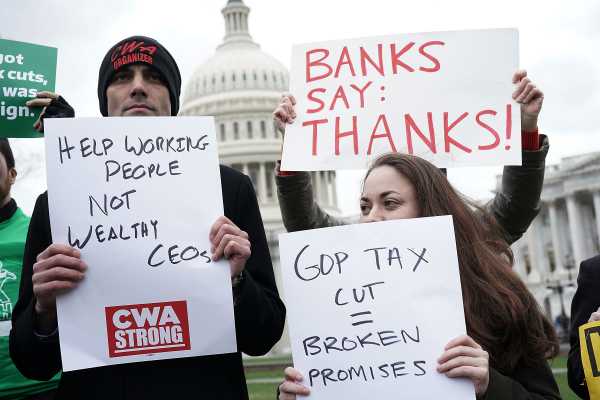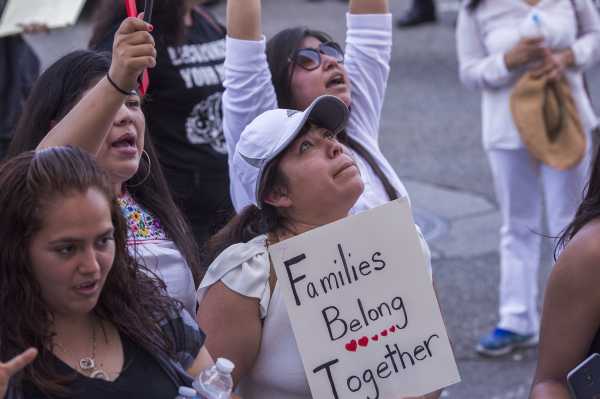
There’s no subtlety in President Donald Trump’s closing message to voters: Be very scared of brown people in this country.
Days from a midterm election, where Democrats look poised to take back control of at least one chamber of Congress, Trump unveiled a modern-day Willie Horton ad — the TV spot used as a textbook example of a racialized attack that George H.W. Bush used against Michael Dukakis 30 years ago.
Hours later he went in front of the camera and said the country was staring down an immigration “crisis” — one that would put the American people in danger and throw the economy in flux.
Let’s be clear about this: There is no imminent border crisis. Trump has been amping reports of refugees still hundreds of miles from the US border — a group that dwindles by the day.
But that doesn’t stop Trump, who has built his political career on scaring white America about the perils of diversity and immigration. He has doubled down on the message as a final rallying cry to Republican voters.
And while Republican lawmakers in competitive races like to say they are running on wholesome kitchen table issues like the economy and tax cuts, Trump has been traveling across the country delivering his racially charged message in full force.
”There is this conventional wisdom that is being perpetuated by Republican consultants with journalists that are embarrassed by Trump, that their races are being won on local issues and that they can block out Trump’s tweets,” Tim Miller, a former Jeb Bush Republican adviser tells me. “That’s not true. It’s garbage.”
“They are running on fear-mongering against immigration and Colin Kaepernick.”
Trump’s closing message in 2018 is the same as his opening message in 2015
At an October rally in Texas for Republican Sen. Ted Cruz, Trump made explicit what has been implicitly clear for years: “I’m a nationalist,” he declared proudly in front of thousands of cheering Trump supporters, encouraging them to vote Republican. White supremacists greeted the statement with enthusiasm.
But Trump’s nationalism is more than his “American First” mantra; it’s deeply rooted in painting some immigrants as criminals, desperate to break unrest and terror to American lands, and others merely as economic foes.
“It does’ take too much analysis to see what that is,” Miller said. “It’s about inciting racial grievance and cultural grievance.”
The campaign video Trump tweeted features footage of Luis Bracamontes, the twice-deported unauthorized immigrant who killed two Sacramento police officers in 2014: “I’m going to kill more cops soon,” Bracamontes is shown saying in court as a caption flashes on the screen: “Democrats let him into our country. Democrats let him stay.”
The final seconds of the campaign video show footage of the thousands of migrants in the caravan marching north toward the US-Mexico border; “Who else would Democrats let in?” the screen reads.
Ever since Trump announced his candidacy for president, he has perpetuated the belief that brown and black people should be feared; feared as un-American for kneeling during the national anthem, for being barbarians from “shithole” countries, and for being “criminals, drug dealers, rapists.”
This isn’t only campaign rhetoric; from the travel ban on Muslim-majority nations, an executive order ultimately upheld in the courts, to separating thousands of undocumented children from their families at the southern border, Trump and his administration have made racial resentment into policy.
This fueled Trump’s rise in 2015. Now, Trump’s race-baiting is being weaponized on the campaign trail once again.
The immigration message is hitting a nerve with the Republican base
When news of the migrant caravan came to light, Trump saw an opening. He’s been stoking racial fears ever since, tweeting, without evidence, that that the caravan contains “criminals and unknown Middle Easterners” and encouraging his base to “remember the midterms” every time they see the caravan.
It’s working. Republicans are most angered by undocumented immigrants crossing the border and by calls to impeach Trump, according to a survey conducted by Reuters and Ipsos gauging emotional response toward the biggest headlines this month.
On a scale of one to 10, with 10 being extremely angry, the survey found Republicans ages 55 and older registered an average 7.9 in anger about illegal immigration. Republicans have consistently named illegal immigration as the biggest problem facing the US, whereas Democrats prioritize health care, gun violence, and climate change.
This reality has made the caravan, still hundreds of miles away from the border, a salient message on the campaign trail.
And as polls begin to even out closer to Election day, there some data that suggests this message might be resonating. A new poll from the Washington Post and Schar School found that 54 percent of voters in battleground district said the “US should do more” to stop undocumented immigrants from crossing the border. Only 25 percent said the United States is currently doing enough.
In Nevada, for example, where incumbent Sen. Dean Heller is one of the most vulnerable Republicans on the ballot this year, immigration tops the list as the biggest priority for voters — and Republicans are polling ahead of Democrats on it. In the most recent Ipsos/Reuters poll, 43 percent of likely voters in Nevada felt Heller had better immigration policy compared to only 33 percent who felt Democratic Rep. Jacky Rosen was better on the issue.
Trump’s fear mongering final message is based on lies

Trump has made the caravan a “crisis.”
“I would like to provide an update to the American people regarding the crisis on our southern border and crisis it is,” Trump said at a press conference, hours after tweeting out the campaign video on murderous immigrants. “People are rushing our border.”
Fox News and other right-wing media outlets have followed suit, showing video footage of thousands of migrants making their way through Mexico, as if the visuals provide some evidence for Trump’s talking points.
The reality is very different. Still in the southern-most part of Mexico, US border officials are far from having to imminently deal with the caravan, half of whom are girls and women, and many of whom want to seek asylum in the United States to flee the violence and economic turmoil in their home country — the same reasons countless refugees have fled to America over the course of its history.
But creating a crisis is the point:
“It’s far less urgent and far less frightening that it is being portrayed as,” Guy Benson, a conservative pundit and editor at Town Hall, told Vox. “It’s clear that immigration is a message that’s highly motivating.”
And Trump drumming up panic isn’t new. Trump’s message on immigration has always been built on lies, as Matt Yglesias writes:
- Contrary to Trump’s depiction, states with more unauthorized immigrants have slightly less violent crime, not more. A similar methodology also suggests unauthorized immigration is associated with significant reductions in nonviolent crime.
- A study looking at metro areas and overall immigration, both legal and illegal, likewise found that immigration is associated with lower crime.
- Immigrants commit fewer crimes than native-born Americans and unauthorized immigrants commit violent crimes at a lower rate than the native population.
And when it comes to Trump’s claim that immigration is a strain on the economy that would make Americans poorer, Trump’s got that backward too. As economists have shown, immigration seems to raise wages for native-born workers while lowering pay for other immigrants.
This doesn’t appear to matter to Trump.
Turns out Republican’s accomplishments aren’t popular enough to win

Republicans’ list of major legislative accomplishments is shorter than they anticipated: They’ve got tax cuts and two conservative Supreme Court justices. While the Republican tax plan is more popular today than it was when Trump signed it into law, it alone is still not getting Republicans excited to head the polls.
So Republicans have changed course on their main message.
In New York, Republicans in Rep. John Faso’s race have been using his African-American opponent’s former rap career to say he doesn’t belong in the predominantly white upstate district. In California, scandal-ridden Rep. Duncan Hunter (R-CA) has been all but calling his Mexican-Palestinian Democratic opponent a terrorist. In Oklahoma, Republican Rep. Steve Russell ran two ads warning of “pipe bombs, shootings, migrant caravans, protests and political attack ads” with footage of the 2014 riots in Ferguson, Missouri, as a threat of what might happen if Democrats are elected. The list goes on.
“I sure would love if Republicans were talking about the highest wage and salary growth in ten years, the lowest unemployment in 50 years,” Benson said. “One of the lessons of politics, voters often don’t vote out of gratitude, they vote out of fear.”
Fear-mongering and race-baiting about MS-13 gangs, Confederate statues, and sanctuary cities are divisive messages that worked for Trump in 2016. And when polls tighten, we’ve seen Republicans turn to these messages as well. It’s just not clear it will staunch the bleeding.
Trump has abandoned the typical general election playbook
In conventional politics, this kind of anti-immigration, race-baiting message is expected of a Republican primary, where candidates duke it out to prove their allegiance to Trump. There’s usually a pivot for the general election; messages typically moderate to appeal to a wider swath of voters.
Trump has fundamentally shifted that calculus. He never pivoted in 2016, and he’s definitely not changing now.
On one hand this makes sense; Republicans are on the offensive in upward of 10 Senate races, where Democrats are defending seats in states that Trump won in 2016 — and culture wars were largely attributed to Trump’s success.
“If Republicans turn out their base, they will pick up Senate seats,” Benson said. “that’s true of some the house seats as well. I’m not of the opinion that there is a carefully plotted strategy — but to the point that we can divine one, it makes sense.”
But there’s a serious question whether this strategy can be translated down the ballot — specifically the more than 105 congressional districts that Democrats think they have a shot at winning.
“Donald Trump only has one playbook and he is running the play,” Miller added. “I don’t know if he is looking at cross tabs to see what kind of message will close in suburban Denver.”

We have seen Republicans’ race-baiting and hardline immigration policy open just as many doors for Democrats as it has for Republicans. According to the Reuters survey, college-educated Democrats registered an average 8.4 on the anger scale over family separations at the border — the result of the Trump administration’s “zero-tolerance” policy, which split roughly 3,000 children from their families.
Trump’s immigration agenda doesn’t fare well among voters overall. More than half of Americans — 58 percent — disapprove of how Trump has handled immigration matters, according to an early July Quinnipiac poll.
This year’s election is a test of which party’s voters are angrier, and immigration is clearly making Republicans mad. But the effects of Trump’s policies, like the images of children being held in cells, are enraging Democrats even more.
Sourse: vox.com






